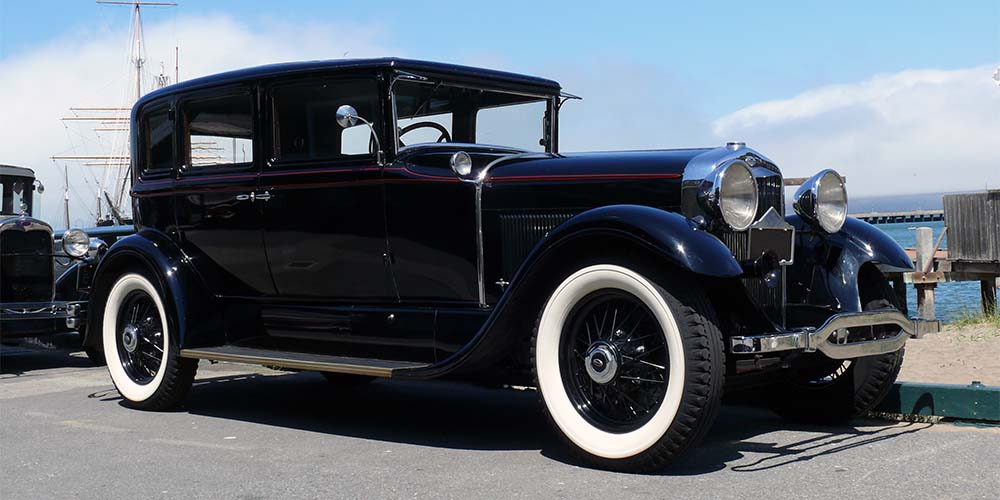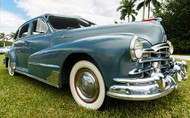The Evolution of Whitewalls
Posted by Agota Szabo on Mar 23rd 2022
They may be passé these days, but whitewalls, sometimes called white stripes, have a long history in U.S. motoring.
Raised white letters, a derivative of whitewalls, remain popular among some truck and SUV owners, especially those who venture off road, and among some pony car drivers, particularly those who have vintage models. Other variations over the years were Uniroyal’s red-stripe performance tires of the 1960s, Goodyear’s Blue Streak tires with their appropriately colored stripe, and Vogue’s gold stripe tire for luxury cars.
Some Facts about Whitewalls:
- Vulcanized rubber in its natural state is off-white.
- Adding zinc oxide makes rubber bright white. Carbon black, which makes rubber durable, gives rubber its black color.
- Whitewalls are a layer added to the drum-shaped tire before it goes into a heated tire mold.
- You can avoid showing the whitewalls or white letters on a vehicle you buy by having the whites mounted on the inside, or spend less and just coat the outer walls with tire black. You’ll have to repeat the tire black coating occasionally.
- The 1960s and 1970s racing tires that inspired street versions with raised white letters had lettering that was merely painted on.
BONUS TIP: There's a way to clean whitewall tires with ease, and we know how. Make sure to read our guide on cleaning whitewall tires. You want to keep them clean and shiny after all.
Whitewalls Style Change Over Time
Rubber tires at first were all off-white, then all white, before carbon black was added to make treads more durable. That left the sidewalls white. Then all-black tires became standard. Over the decades, the stripes got narrower until they disappeared. Fender skirts in the 1950s-70s had something to do with it, since they covered up the whitewalls. Wider use of alloy wheels, which just didn’t match well with whitewalls, also furthered their decline.
Although whitewalls are offered on few new, contemporary tires, they are still available on tires made to fit classic cars. If you have a classic, whether restored or still running and looking good after being handed down from your Great Aunt Matilda, do you know which whitewalls are appropriate for that car’s era?

Here’s a guide—a light look back at different eras and white stripes of all varieties and styles.
The 1920s and 1930s
A stylish option, whitewalls were a whopping 4 to 5 inches wide on the era’s tall sidewalls. They looked great on a Deusenburg.
The 1940s
As the decade opened with the world at war, whitewalls disappeared—and so did civilian tires of almost any type, except retreads. After the war, whitewalls, usually an option, measured around 3 inches or a bit more.
The 1950s
Whitewalls were quite popular, especially on higher-priced models but even on grocery getters. Thunderbirds and Corvettes, both of which in those days had wheels covers on steel wheels, rode on whitewalls. They measured 2½ to a little under 3 inches wide through 1956. They shrank to 2¼ to 2½ inches after that and stayed that way until 1962.
The 1960s
Big changes came to whitewalls. In 1962, they shrank to about an inch, except on luxury lines. Some luxury cars, including Cadillac and Lincoln, had three narrow bands of white on each outer sidewall later in the decade. Performance cars, including the Pontiac GTO and Chevrolet’s Corvette and Chevelle SS 396, got narrow red stripes, and others got a narrow blue stripe. A few highline Fords got a red stripe and a white stripe. Goodyear put white letters on its Polyglas high-performance tires, Firestone on its Wide Ovals and BF Goodrich on its Radial T/As. Stripes got as narrow as ¾ inch. Whitewalls were no longer offered on the Corvette after 1968.
The 1970s
Narrow whitewalls continued to be popular, but more cars—especially performance models and pseudo performance cars in a decade when power dropped—got white letters. Black walls were making a comeback.
The 1980s
Black sidewalls increasingly returned to prominence, with some higher-priced American models getting narrow white stripes and some performance cars getting white letters. Newer low-profile tires often were black.
The 1990s
Whitewalls became rare, with the few that were left measuring about ¾ inch or less.
The 2000s
Stripes disappeared completely for most tire lines. Raised white letters were pretty much reserved for SUV and truck tires, and for some performance or lower-cost cosmetic performance tires.
Old-Look Whitewalls
Several companies that bought up old tire molds make whitewall tires in vintage sizes. Some are bias plies, like the originals, while others are modern radials underneath with an appearance that duplicates the old tires. They typically cost two or three times what decent modern radial costs new.
And there’s a catch: Some radials don’t fit the old rims.
















